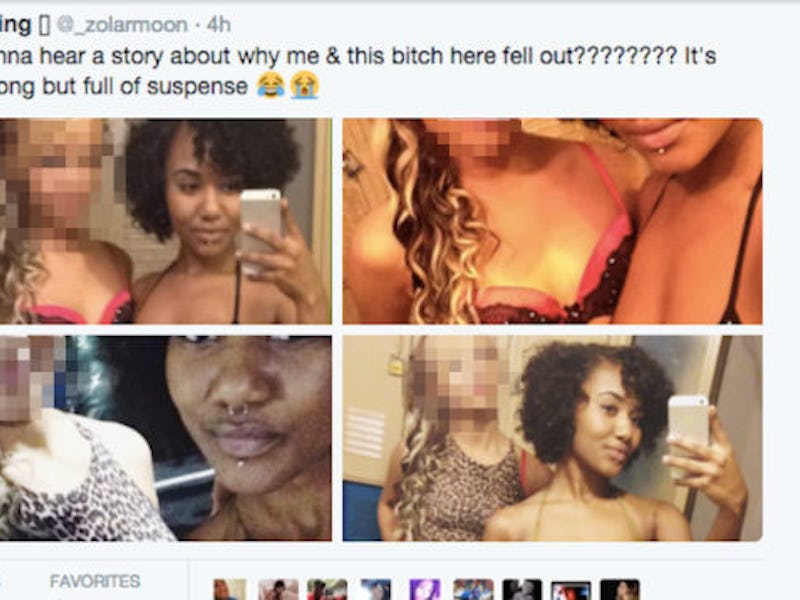"Zola" and the Benefits of Social Media Storytelling
Examining the unique appeal of "Zola," and some other notable social media-related narratives.

Over the past couple of days — as you probably already know — the near-150-entry tale of trapping, tricking, and Florida motel skullduggery tweeted by the account @_zolarmoon has taken off in an unprecedented way — possibly, more than its author wants.
It’s being heralded by some as the next great American short story, and gained widespread attention on Twitter and in the media. Selma director Ava DuVernay has sung its praises as a great piece of “hood” art; some view it as an entertaining but false piece of ephemera. Whether or not it is true (I believe that it is), Zola’s tale is a gripping, funny, and evocative piece of writing — hardboiled, pithy pulp narrative for the social media era — and a lot more than just the Meme of the Day.
Perusing Twitter’s darkest corners you will find many amateur storytellers, who’ve developed a way with the medium due to obsessive use and a no-filter approach. Popular, “highbrow” art has come to reflect the oversharing times we live in— see Karl Ove Knausgaard’s detailed, unabashedly self-absorbed oversharing in his bestselling My Struggle series, or the slice-of-life, sometimes noxious outpourings of Mark Kozelek’s Sun Kil Moon project.
“Zola”‘s story, perhaps, is different than the typical Twitter inner-monologue purge. It creates the impression of a live storyteller working its audience — embellishing a story they’ve told many times before. It uses the language of Twitter — the crying-with-laughter and skull emoji can often speak louder than words — and the restrictions of the length of each entry to build suspense and heighten the “Oh shit” quotient. Most important, it offers a unique perspective and a penetrating look into the experience of sex workers in this country. “Zola”‘s is a story we rarely see told with so much detail and transparency.
In other words, it makes a case for the Twitter short story as being a great and effective form of serial storytelling. Other authors and Twitter personalities have experimented with the possibilities of the format, sometimes in a more experimental vein. If you liked “Zola” and idle Twitter scrolling in general, here are some other internet narratives you might want to check out
1. David Mitchell’s short story in Tweets
That’s right, the Cloud Atlas and The Bone Clocks author — who espouses a love for “straitjacket”-like restrictions when approaching a project — wrote a typically trippy, fractured short story in Tweets last year. It uses the pointillistic structure to evoke a boy’s dissociative experience while tripping on stolen Valium pills.
Read the 280-tweet story here.
Mitchell’s comments about the story to The Guardian speak to some of the formal appeal of Twitter fiction, which for him is kind of disorienting and phantasmagoric: “Reading a series of tweets is more like looking through a narrow window from a train speeding through a landscape full of tunnels and bands of light and dark. Each tweet erases its predecessor.”
2. Clinton Yates and #AfternoonTwitterTales
Washington Post writer Clinton Yates is known for offering up multi-tweet sagas, signaling the beginning of a new thread with the #AfternoonTwitterTale (or Tales) hashtag. Some have been organized on Storify — read the tale of a college-years car crash which ends with a moment of catharsis to the strains of Lit’s “My Own Worst Enemy” here
3. Jennifer Egan’s “Black Box”
The New Yorker Tweeted a detached, axiom-filled story by A Visit From the Goon Squad author Jennifer Egan in 2012. The tone is almost like prose poetry — built from scraps from Google search results and errant TED talk Powerpoint slides — and woven artfully into a pseudo-narrative.
4. Elliott Holt’s multiple-Twitter-account Whodunit
Fans of Zola’s style (and maybe Serial) will be most attracted to journalist and novelist Elliott Holt’s Twitter fiction classic — a murder mystery which weaves together accounts told by separate characters, each using separate Twitter accounts. This project — part of 2012’s Twitter Fiction Festival — was also an interactive experiment: After its conclusion, readers were asked to tweet whether they believed the murder to be a #homicide, #suicide, or #accident.
The whole thing was compiled by Twitter here.
5. A novel in GIFs
It wasn’t on Twitter, but Dennis Cooper’s horror novella Zac’s Haunted House uses one of the site’s most prevalent tools of communication — the GIF — to take us on an uncanny, carefully patterned journey. No, it doesn’t quite manage to paint a narrative just through the textless images. Published by Kiddiepunk.com, Cooper’s five-chapter work is available to read and download here. It’s a perfect Halloween “read.”